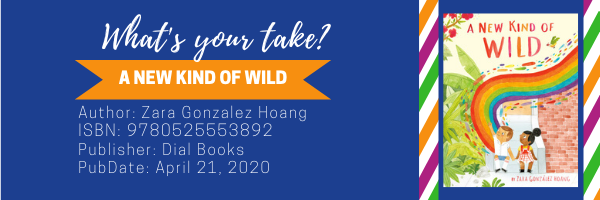By Seemi Aziz, The University of Arizona, Tucson, AZ and Janelle B. Mathis, University of North Texas, Denton, TX
As we conclude our week of introducing titles that for us speak to the many aspects of displacement, A New Kind of Wild shares a story that represents how local and applicable the notion of displacement can be for young readers. There are many ways that children are displaced in their daily life—required family moves to other communities or cities, family separations, feelings of not belonging, bullying, and other ways that emotional and physical displacement can occur. A New Kind of Wild is best described by the author’s dedication: “And to anyone who has had to leave a place they love for somewhere new, this is for you” (Hoang, 2020). Ren has always lived in the rainforest where, during the day, he imagines adventures with dragons, unicorns, fairies and kings while surrounded by nature. He must move to the city where he was lonely and finds nothing that stirs his imagination. Then he meets Ava who has always lived in the city and shares with Ren the imaginative wonders of her city life.
JANELLE: While this move to the city was not because of conflict or complexities that added layers of concern regarding displacement, homesickness is real for all when permanently displaced, and all ages of readers can empathize with Ren. Several thoughts remained as I read this story several times through both words and images. One is that a child’s imagination is open to many ways of creating the imaginary world–whether in the rain forest or the city. However, these imaginary worlds for young children are directly connected to their early environments and the time they have to explore these environments. In Ren’s case, he obviously was exposed to story since his adventures included fantasy characters and scenes. His physical displacement affected his mental and emotional displacement as he was unable to conceptualize the stories he had built within his natural world.
The second thought is the importance of a friend, Ava, to step in during this displacement and share the new context and its possibilities for adventure and imagination. And yet another important thought related to why this book was chosen as part of a focus on displacement is that of how do we share the many stories of children displaced by conflict, immigration, tacit segregation, bullying, and other critical issues in ways that child readers can relate and begin to create empathy and understanding for the situation. By using books that relate displacement in contexts which children can connect to their own lives, they can potentially build understandings as to the challenges others face when separated from the people and contexts they know and love. Starting with stories that may seem simple to the adult reader but offer more complex situations for young children, teachers and parents can increasingly share stories about situations that are not part of a child’s life but ones he/she can relate to over time. While we have shared only several books that utilize well the theme of physical and emotional displacement, we have listed at the end of this, our final week, books we find powerful in the message they provide for the reader about displacement in the lives of young people.
SEEMI: This story explores rural to urban displacement. I especially appreciated how the meaning of what makes a home is explored in this text as seen in Ren, who grew up in a rural community where his life was familiar but very different from a city filled with unfamiliar noise and atmosphere. I absolutely agree with the concept of homesickness presented in this simple yet complex tale. The author drew from her dad’s childhood experiences as she penned the story. The story reads lyrically and the life in the jungle is presented as full of imagination, magic and wildness. As Ren befriends Ava in the city, she shows him a new world that was just as wild as his rainforest home. She listened to all that he was sharing about his home and then showed him how wonderful the city can be. The simplicity of the text and illustrations add to the complexity of the story in a beautiful manner. Even though both of the characters are different from each other and their backgrounds differ, they could connect to each other. This is a great message especially in this day and age.
More books with the theme of Displacement:
Picture Books:
A Sky Without Lines (2019) Krystia Basil and Laura Borrás
Lubna and Pebble (2019) Wendy Meddour and Daniel Egnéus
The Day War Came (2018) by Nikola Davies & Rebecca Cobb
Me and My Fear (2018) Francesca Sanna
The Mediterranean (2018) by Armin Greder
Away (2017) Emil Sher and Qin Leng
The Island (2008) by Armin Greder
Adolescent/chapter books:
When Stars are Scattered (2020) Victoria Jamieson and Omar Mohamed (graphic novel)
King and the Dragon Flies (2020) Kacen Callender
Internment (2020) by Samira Ahmed
A Place to Belong (2019) by Cynthia Kadohata
We are Displaced (2019) by Malala Yousaf Zai
For Black Girls Like Me (2019) Mariama J. Lockington
Echo (2015) by Pam Munoz Ryan
Title: A New Kind of Wild
Author: Zara Gonzalez Hoang
Publisher: Dial Books
ISBN: 9780525553892
Date Published: April 21, 2020
Throughout June 2020, Seemi and Janelle give their takes on books that feature physical and mental displacement. Check back each Wednesday to follow the conversation!
- Themes: Janelle Mathis, New Kind of Wild, Seemi Aziz, Zara Gonzalez Hoang
- Descriptors: Books & Resources, My Take/Your Take

